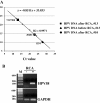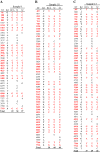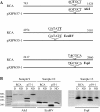Genome sequencing accuracy by RCA-seq versus long PCR template cloning and sequencing in identification of human papillomavirus type 58
- PMID: 24410913
- PMCID: PMC3903022
- DOI: 10.1186/2045-3701-4-5
Genome sequencing accuracy by RCA-seq versus long PCR template cloning and sequencing in identification of human papillomavirus type 58
Abstract
Background: Genome variations in human papillomaviruses (HPVs) are common and have been widely investigated in the past two decades. HPV genotyping depends on the finding of the viral genome variations in the L1 ORF. Other parts of the viral genome variations have also been implicated as a possible genetic factor in viral pathogenesis and/or oncogenicity.
Results: In this study, the HPV58 genome in cervical lesions was completely sequenced both by rolling-circle amplification of total cell DNA and deep sequencing (RCA-seq) and by long PCR template cloning and sequencing. By comparison of three HPV58 genome sequences decoded from three clinical samples to reference HPV-58, we demonstrated that RCA-seq is much more accurate than long-PCR template cloning and sequencing in decoding HPV58 genome. Three HPV58 genomes decoded by RCA-seq displayed a total of 52 nucleotide substitutions from reference HPV58, which could be verified by long PCR template cloning and sequencing. However, the long PCR template cloning and sequencing led to additional nucleotide substitutions, insertions, and deletions from an authentic HPV58 genome in a clinical sample, which vary from one cloned sequence to another. Because the inherited error-prone nature of Tgo DNA polymerase used in preparation of the long PCR templates of HPV58 genome from the clinical samples, the measurable error rate in incorporation of nucleotide into an elongating DNA template was about 0.149% ±0.038% in our studies.
Conclusions: Since PCR template cloning and sequencing is widely used in identification of single nucleotide polymorphism (SNP), our data indicate that a serious caution should be taken in finding of true SNPs in various genetic studies.
Figures



Similar articles
-
A sequence-independent strategy for detection and cloning of circular DNA virus genomes by using multiply primed rolling-circle amplification.J Virol. 2004 May;78(10):4993-8. doi: 10.1128/jvi.78.10.4993-4998.2004. J Virol. 2004. PMID: 15113879 Free PMC article.
-
Multiply-primed rolling circle amplification of human papillomavirus using sequence-specific primers.Virology. 2012 Oct 10;432(1):57-62. doi: 10.1016/j.virol.2012.05.030. Epub 2012 Jun 26. Virology. 2012. PMID: 22739442
-
Whole-genome analysis of human papillomavirus genotypes 52 and 58 isolated from Japanese women with cervical intraepithelial neoplasia and invasive cervical cancer.Infect Agent Cancer. 2017 Aug 4;12:44. doi: 10.1186/s13027-017-0155-4. eCollection 2017. Infect Agent Cancer. 2017. PMID: 28785305 Free PMC article.
-
Worldwide genetic variations in high-risk human papillomaviruses capsid L1 gene and their impact on vaccine efficiency.Gene. 2021 May 25;782:145533. doi: 10.1016/j.gene.2021.145533. Epub 2021 Feb 23. Gene. 2021. PMID: 33636291 Review.
-
Polishing the craft of genetic diversity creation in directed evolution.Biotechnol Adv. 2013 Dec;31(8):1707-21. doi: 10.1016/j.biotechadv.2013.08.021. Epub 2013 Sep 6. Biotechnol Adv. 2013. PMID: 24012599 Review.
Cited by
-
Characterization and Diversity of 243 Complete Human Papillomavirus Genomes in Cervical Swabs Using Next Generation Sequencing.Viruses. 2020 Dec 14;12(12):1437. doi: 10.3390/v12121437. Viruses. 2020. PMID: 33327447 Free PMC article.
-
MitoRCA-seq reveals unbalanced cytocine to thymine transition in Polg mutant mice.Sci Rep. 2015 Jul 27;5:12049. doi: 10.1038/srep12049. Sci Rep. 2015. PMID: 26212336 Free PMC article.
References
LinkOut - more resources
Full Text Sources
Other Literature Sources
Miscellaneous

